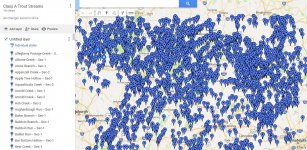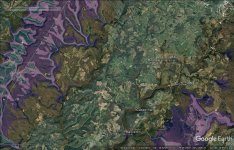silfeid
New member
- Joined
- Apr 6, 2017
- Messages
- 26
Hi All,
I'm trying to find information about some streams located on or near State Game Lands 111 in Somerset County, and the ol' Google isn't of much help, so I thought I'd try posting here.
One of my last posts was about the area between the mouth of Cranberry Glade Run and Whipkey Run on Laurel Hill Creek, and after hiking into the area, I can say that it's absolutely beautiful down in there, although the illegal ATV riders were a bit annoying. As far as the fishing on Laurel Hill Creek goes, we'll give it another try this season with the stockies, but fishing in August and early September, all we caught were some bluegill and rock bass - fun, but not the quarry we'd been seeking. My suspicion is that Laurel Hill Creek just gets too warm by July to allow more than a bare handful of trout to hold over. Really wish the dam at the lake could be converted to feed from the bottom instead of the top...
The streams that feed into Laurel Hill Creek down that way are really stunning though - classic Laurel Highlands freestone mountain streams. We didn't get a chance to fish them, but I've been doing some wintertime hiking scouting them out, and researching online as well. Although the scenery is great and most of them have a fair number of plunge pools, I've yet to eyeball a trout, which might not mean much. The internet would seem to indicate that water quality is good and that they hold trout, but there's not a lot of evidence to go on.
What I'm wondering is if anyone on the forum has fished any of these streams for natives? Specifically I am talking about Sandy Run (above and below the bridge on Sandy Run Road), Cranberry Glade Run, Harbaugh Run, Flugey Hollow Run, Whipkey Run, and Green King Run. I have found some stuff indicating that a few of these hold fish, but the info is dated and very brief.
I'm trying to find information about some streams located on or near State Game Lands 111 in Somerset County, and the ol' Google isn't of much help, so I thought I'd try posting here.
One of my last posts was about the area between the mouth of Cranberry Glade Run and Whipkey Run on Laurel Hill Creek, and after hiking into the area, I can say that it's absolutely beautiful down in there, although the illegal ATV riders were a bit annoying. As far as the fishing on Laurel Hill Creek goes, we'll give it another try this season with the stockies, but fishing in August and early September, all we caught were some bluegill and rock bass - fun, but not the quarry we'd been seeking. My suspicion is that Laurel Hill Creek just gets too warm by July to allow more than a bare handful of trout to hold over. Really wish the dam at the lake could be converted to feed from the bottom instead of the top...
The streams that feed into Laurel Hill Creek down that way are really stunning though - classic Laurel Highlands freestone mountain streams. We didn't get a chance to fish them, but I've been doing some wintertime hiking scouting them out, and researching online as well. Although the scenery is great and most of them have a fair number of plunge pools, I've yet to eyeball a trout, which might not mean much. The internet would seem to indicate that water quality is good and that they hold trout, but there's not a lot of evidence to go on.
What I'm wondering is if anyone on the forum has fished any of these streams for natives? Specifically I am talking about Sandy Run (above and below the bridge on Sandy Run Road), Cranberry Glade Run, Harbaugh Run, Flugey Hollow Run, Whipkey Run, and Green King Run. I have found some stuff indicating that a few of these hold fish, but the info is dated and very brief.





